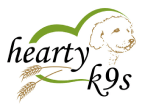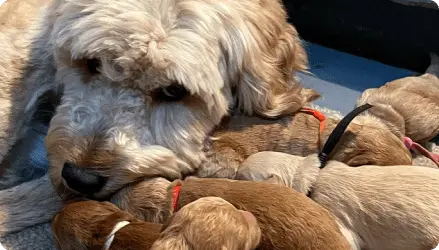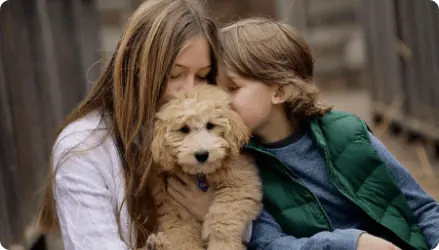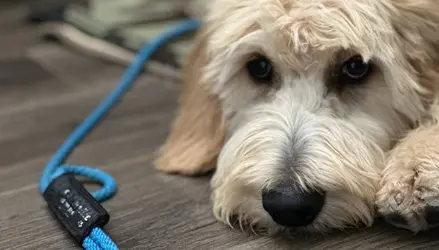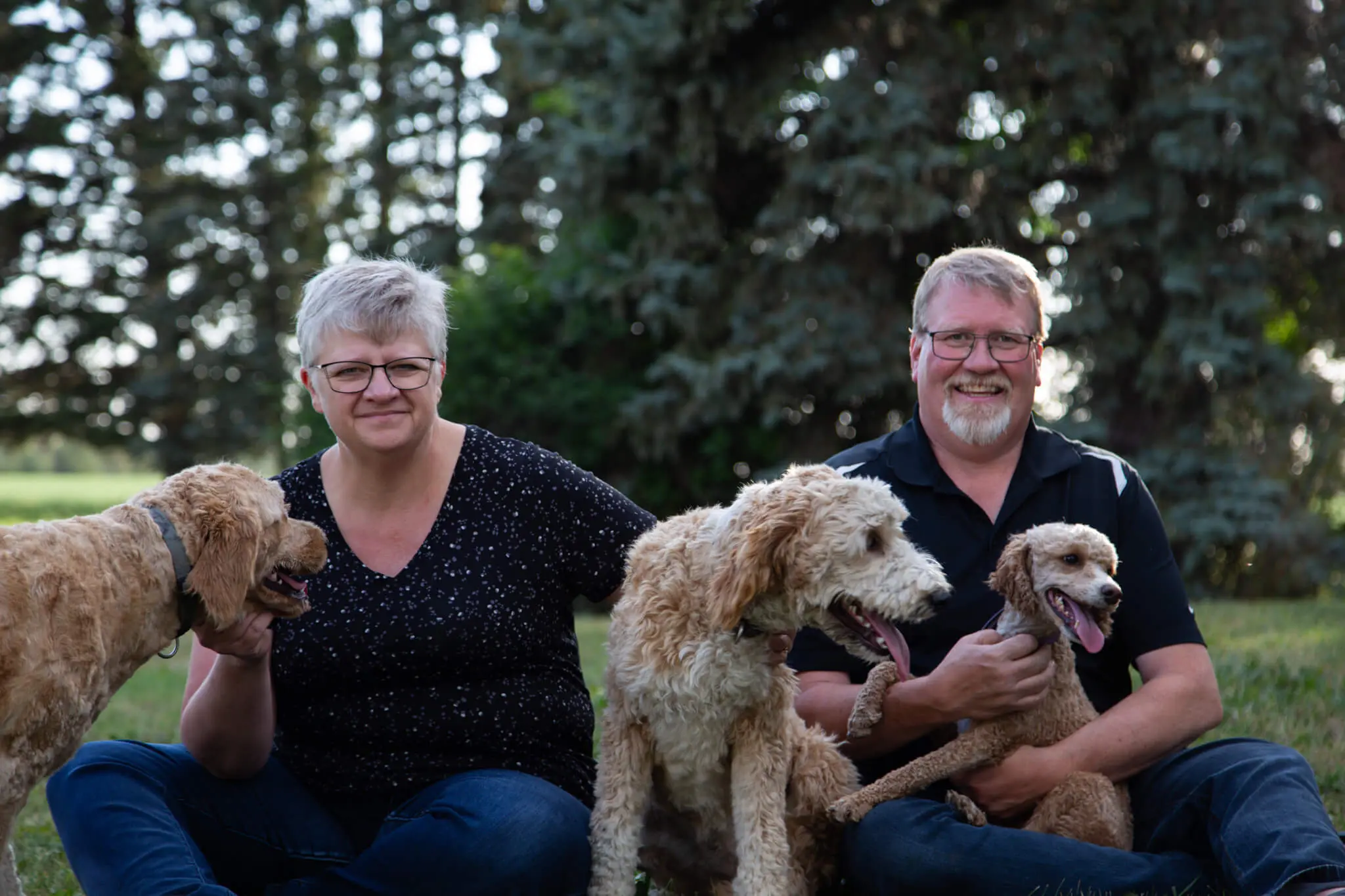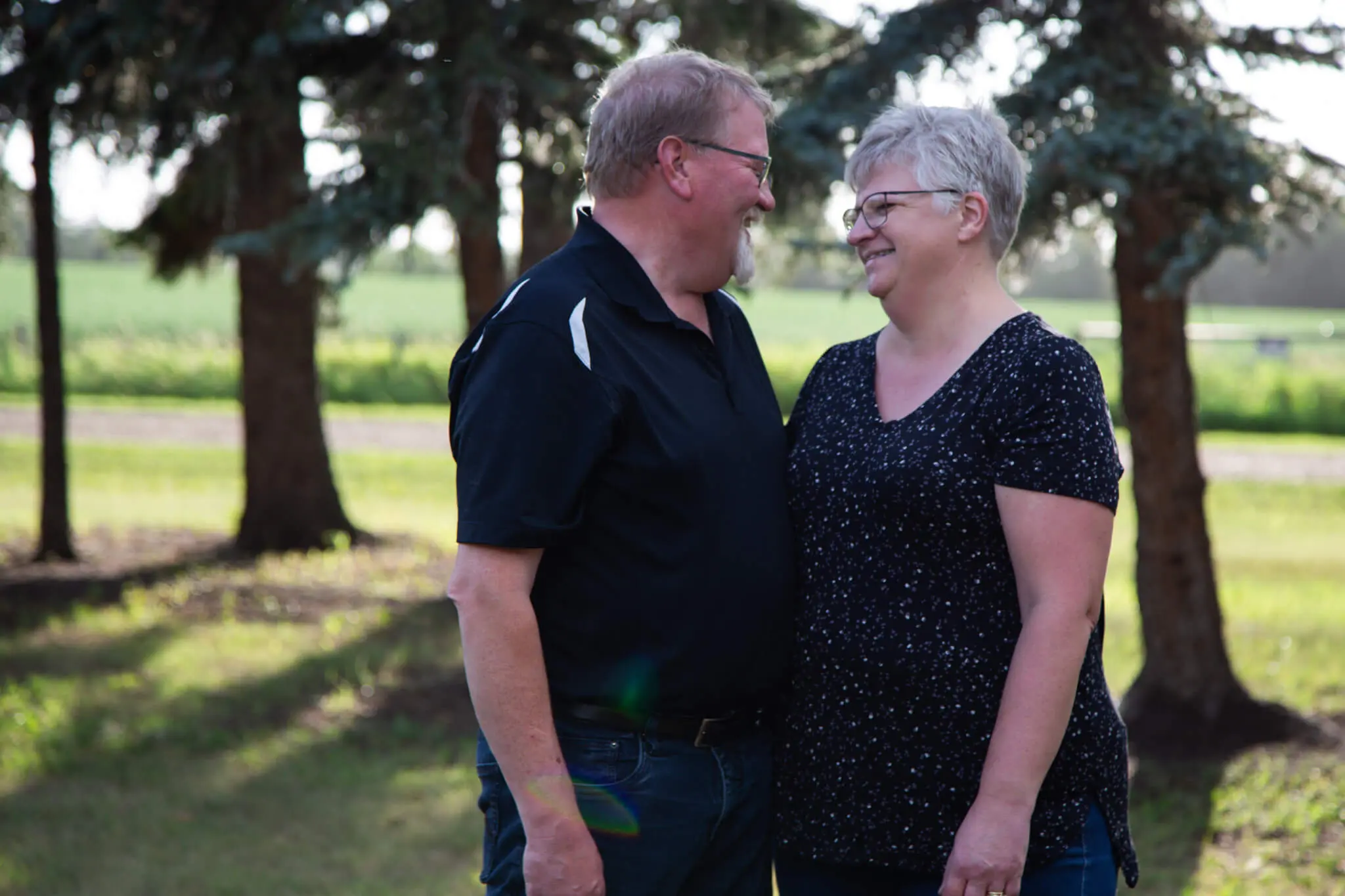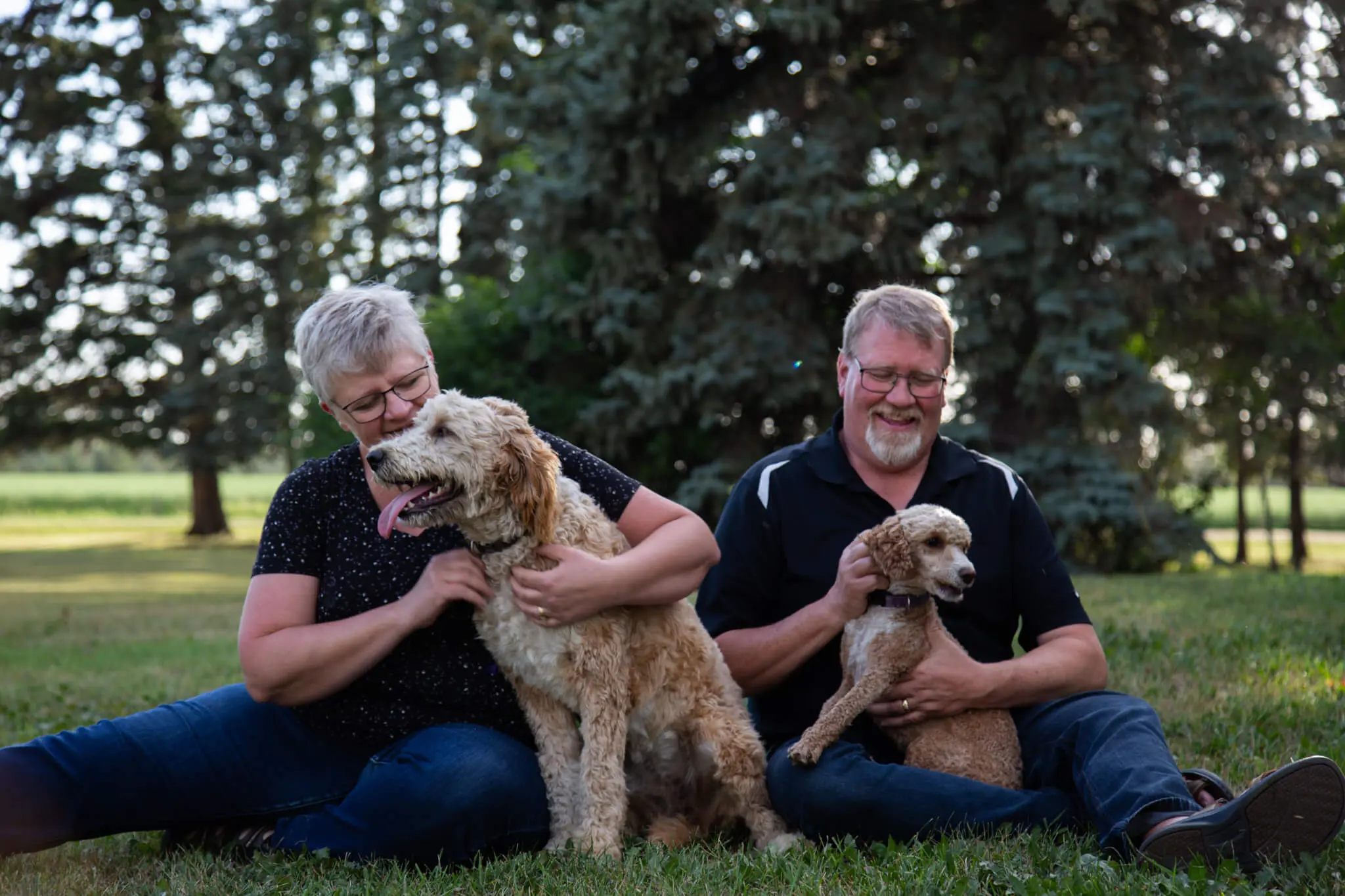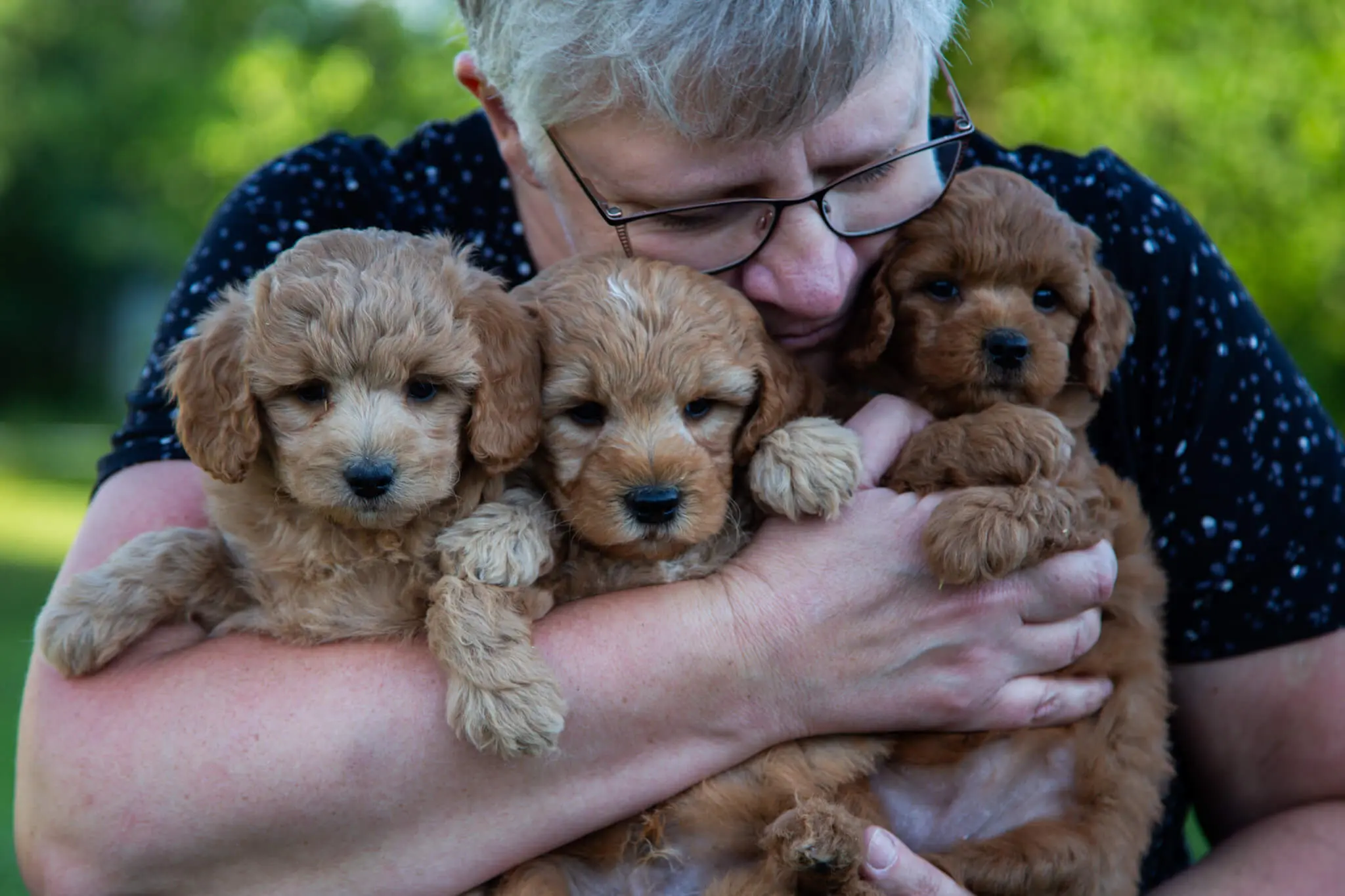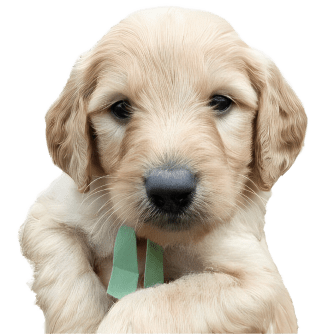Welcome to Hearty K9s
Trusted Goldendoodle Breeders in Alberta!

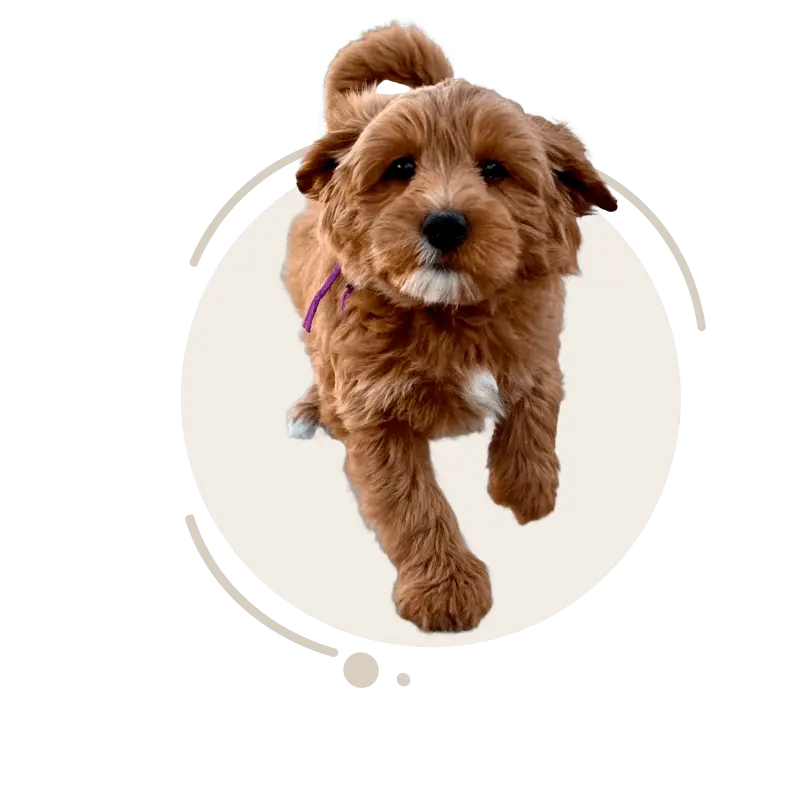
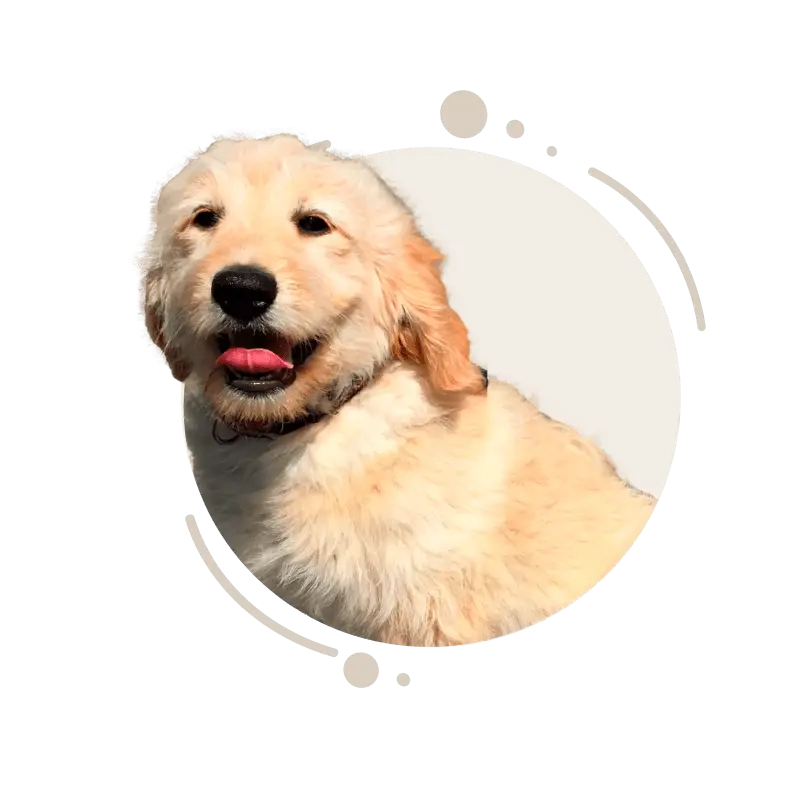
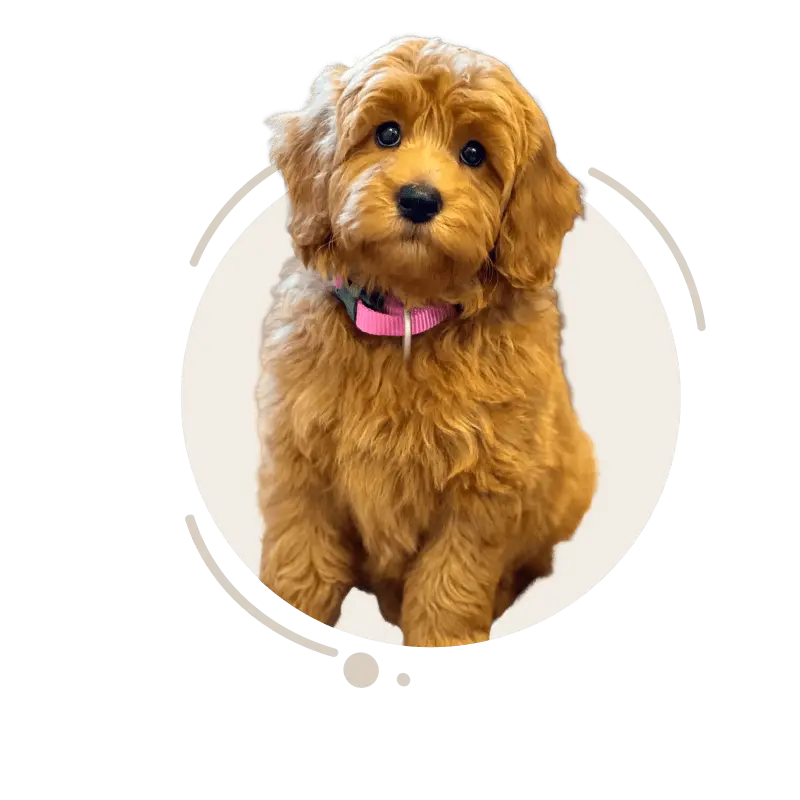

Goldendoodle Puppies for Adoption in Alberta
How We Raise Hearty K9s pups
We proudly serve families across Alberta, helping you find the perfect Goldendoodle puppy. We at Hearty K9s believe that dogs are a true gift to humankind. We are committed to actively and purposely socializing each pup to become all that they can be to transform lives and mend hearts.
Pups in the same litter can be very different from each other. We're mindful of their needs and honour their differing paces of growth and development.

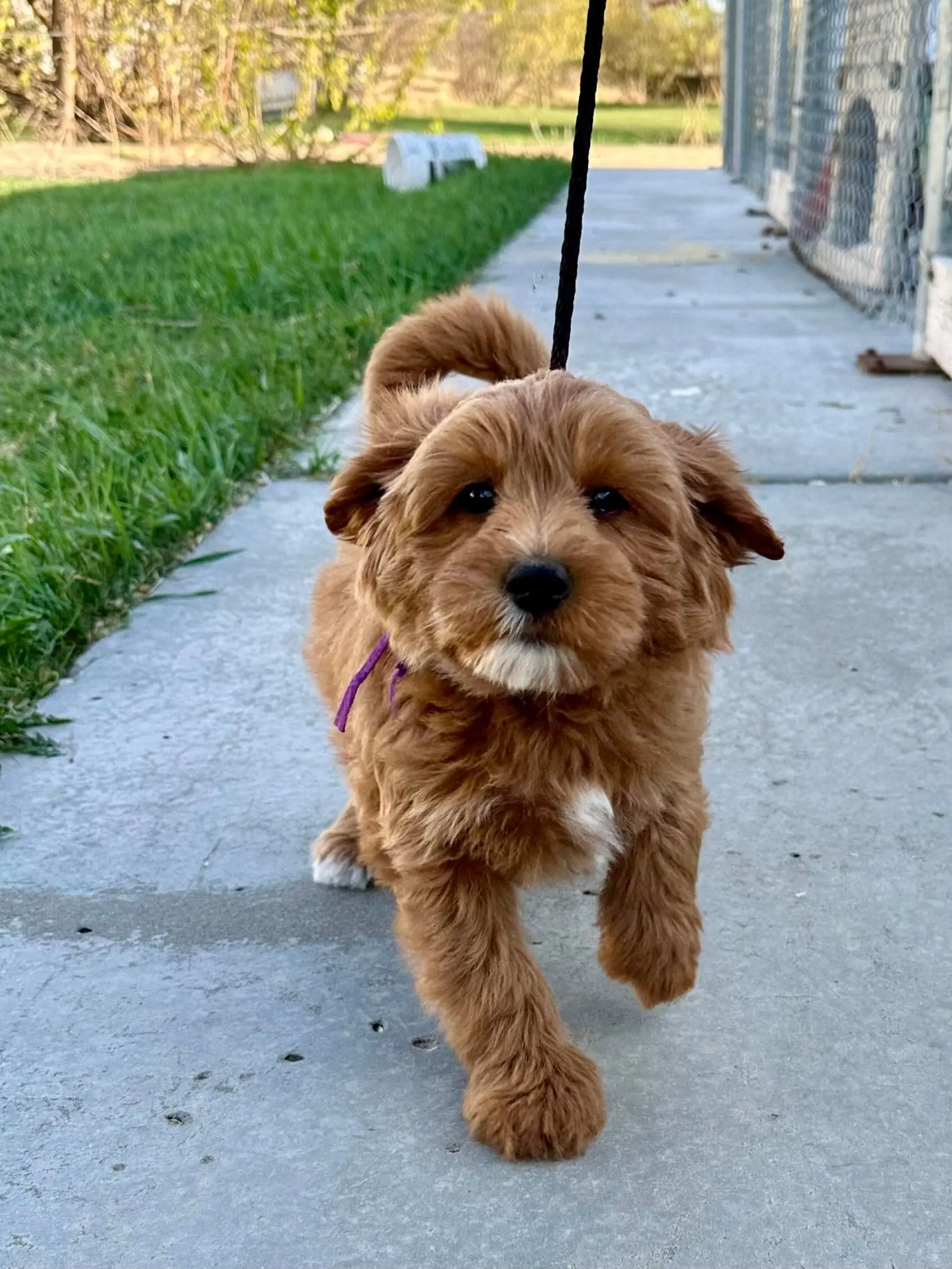
Goldendoodles are Amazing companions
Goldendoodle Quality Checklist









Our Goldendoodle Breeding standards
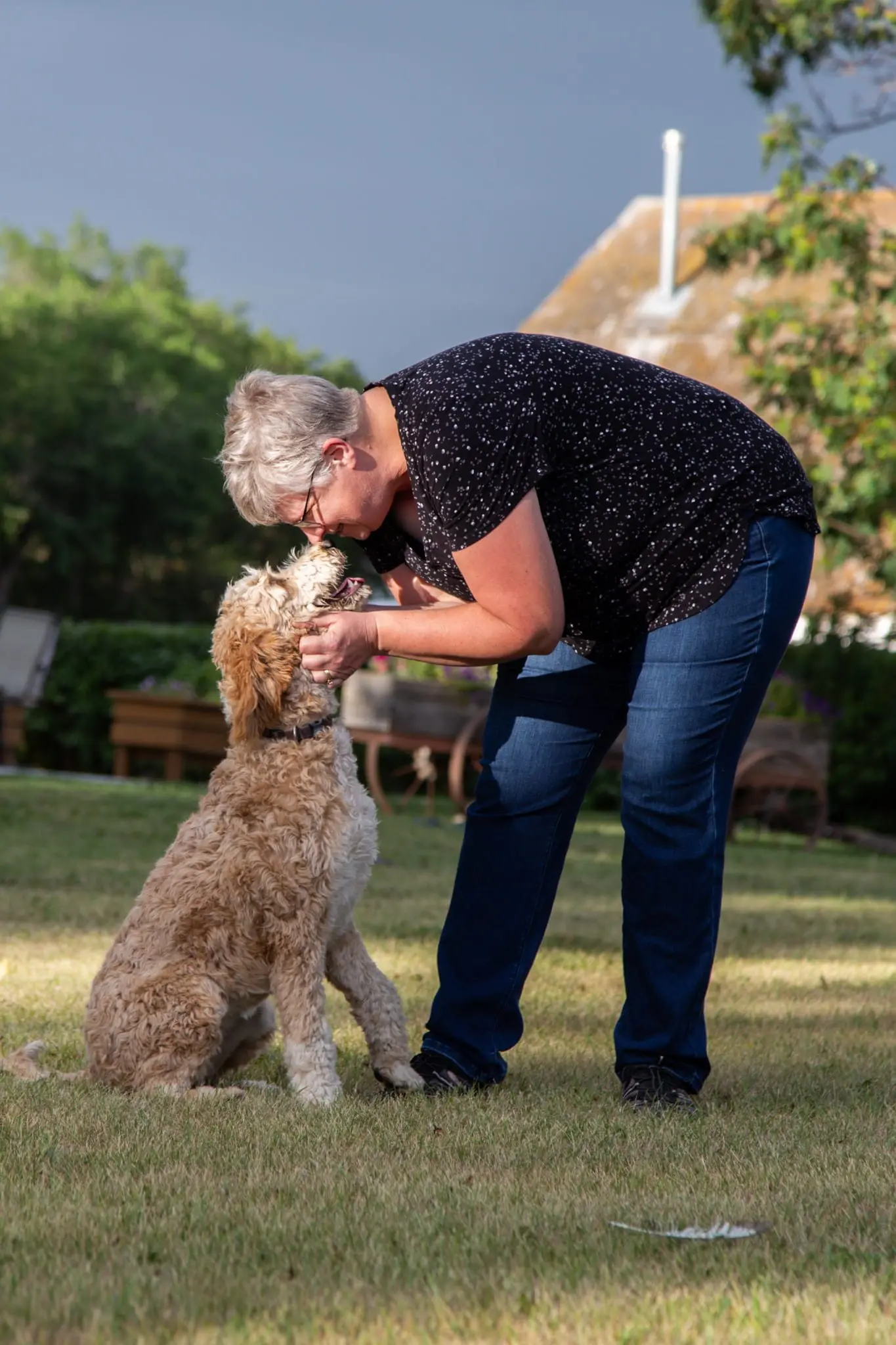
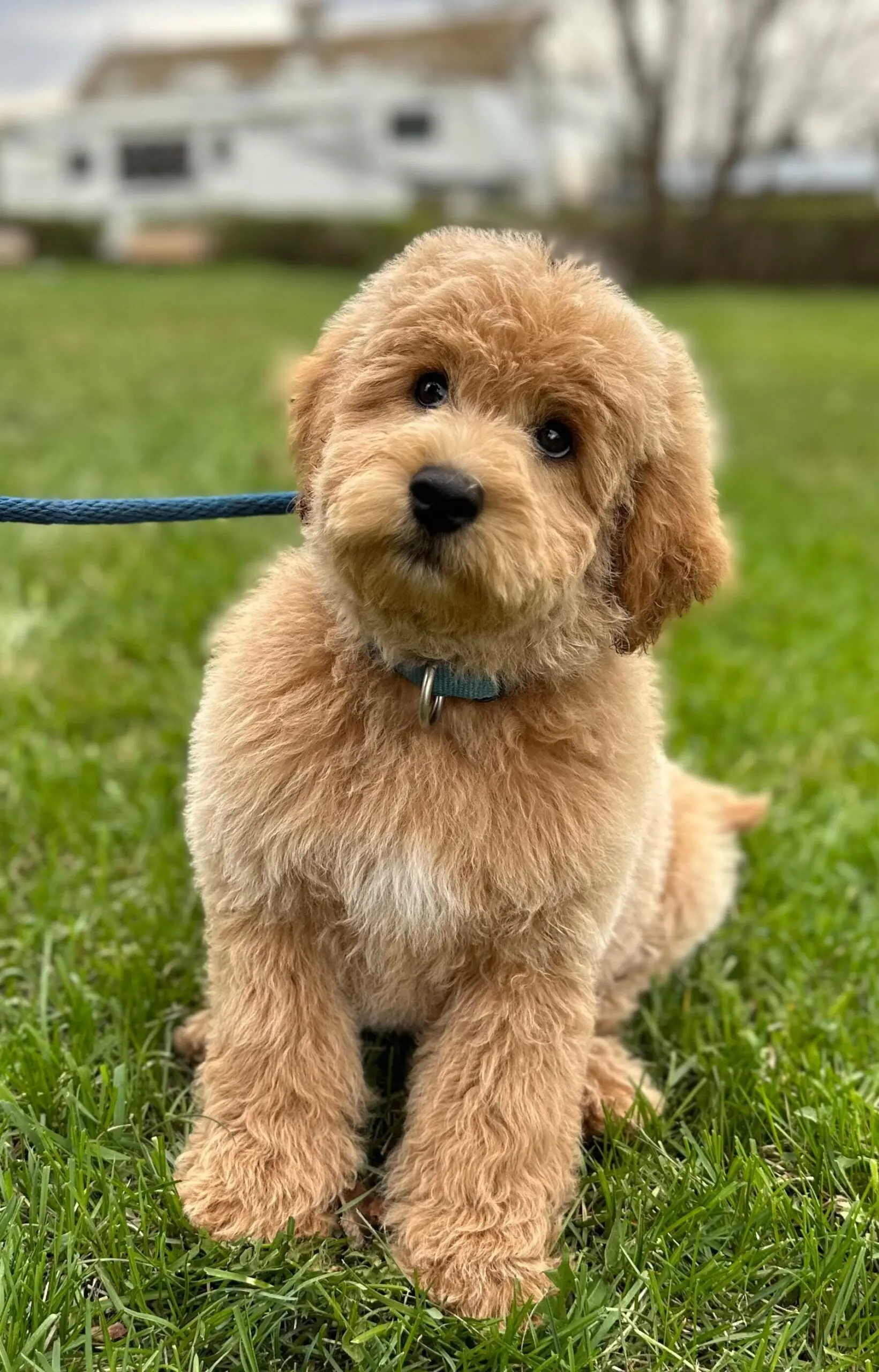
Testimonials
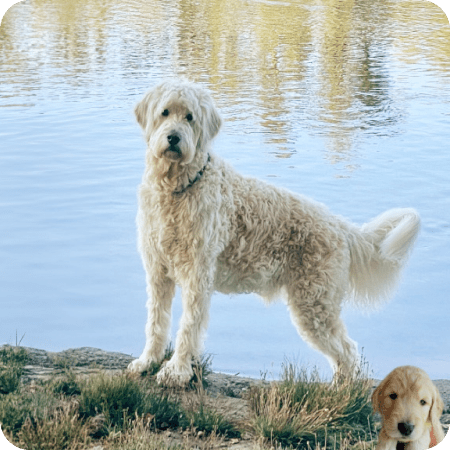
Cathy and Dave
Puppy Program
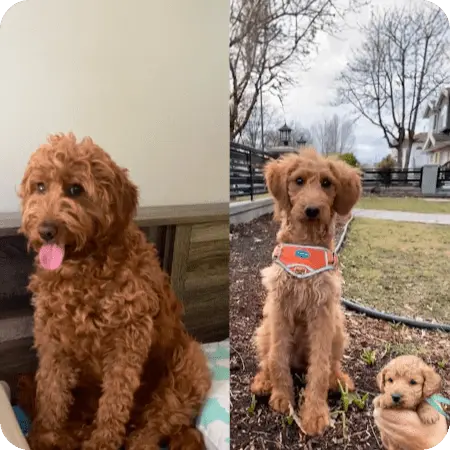
I'd like to share with you the pictures of Mika at 6 months and now. I noticed your flatter coat doodles take a longer time to find a home. Mika's coat was quite flat when she was younger but she's grown into this beautiful wavy hair doodle! She's 28lbs now and turning two by end of September.
She is so gentle and playful and very eager to please. With her wonderful temperament she makes lots of furry friends, and all of my neighbours and friends just love her.
Kelly
Puppy Program

Patty, Dorian & Revy
Puppy Program

Hi Sonia, I hope you are well!
I was thinking of you. We took Scully for her first haircut as we are going camping next week. Our groomer sang her praises for being so good. She actually commented that Scully is not like other doodles. That actually both of our doodles have been exceptional. I told her it is because they both came from an exceptional breeder.
Scully is doing really well, definitely a crazy puppy at times. But such a good puppy, very intuitive, smart and cuddly! She is very people focused, just loves everyone.
I have attached a before and after haircut picture. Hard to believe she is 5 months old already. We just love her! Thanks for all you do and for giving us such great dogs. Cooper was amazing and Scully is following in his foot steps. Such good dogs ?? Take care,
Jodie
Puppy Program
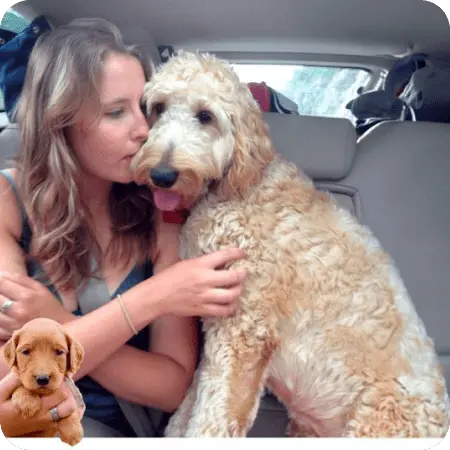
Because of your advice and wisdom we were able to become responsible and responsive dog owners. The books you recommended, the philosophies they outlined, the guidelines they discussed, gave us insight as to how to successfully raise a puppy.
We wanted to thank you again for giving us this wonderful puppy. She is the result of your high standards of breeding, your commitment to excellent health, and the support you give puppies prior to leaving their mother.
With Best Wishes,
Ron, Pat and Catrin
Puppy Program
Frequently Asked Questions About Goldendoodles
- F1: Golden retriever crossed with a poodle.
- F1B: F1 crossed back to a poodle.
Colours range from red and apricot/golden to cream and bicoloured
My focus as a breeder is health and temperament. To have a loyal, well-balanced dog that is healthy and lives a long life means the most to me, and it is what I strive for in my pups.
Sometimes, people leave deposits for a pup as much as a year in advance, so I encourage folks who have recently committed to wait for a pup from Hearty K9s to start the adoption process as soon as possible. Most of the time, the wait for a pup is not very long, but it depends on pup availability and the number of previously approved applicants.
The adoption process is straightforward to complete and can be finalized quickly in some cases. We've outlined these steps so you can be prepared and relaxed the day you choose your pup.
These are the nine steps involved in the adoption/choosing process:
1. Fill out the adoption form fully and submit it to Hearty K9s when you have committed to adopt a pup from us.
2. Wait for the adoption application to be approved. We will contact you for further information during this time.
3. Pay the deposit and consequently get placed on the waiting list. Previous applicants get 1st choice, so it's essential to get your application for adoption into us early.
4. Read the books we've recommended for you. Reading is one of the most critical steps (and a requirement) to prepare for your pup. The sooner you start, the better for everyone involved.
5. When the litter is 6-7 weeks old, we'll contact you if previous applicants do not already fill the spots for the pups. At this time, we'll make an appointment with you to come and choose your pup and, subsequently, when you plan to take your pup home. If you cannot come during your allotted time, you can choose your pup by communicating through emails, photos, and phone calls. Depending on applicants' schedules and number of clients that day, there can be limited flexibility in scheduling your time slot.
Alternatively, at times, choosing happens on the same day or is very close to the same as a take-home day. The reason is that in more recent years, it has been recommended that their vaccines should be closer to 8 weeks, and puppy evaluations are also more beneficial when done between 7 and 8 weeks (the older, the more accurate it can be).
6. Bring your list of questions to the appointment and review the order of preferences you have for a pup before you arrive. Review your copy of the adoption form you submitted to us to determine if your preferences have changed. Inform us of any changes if you haven't done so already.
7. You can pay the balance owing for your pup on the "choosing day" appointment with a personal cheque as long as it is at least a week before you pick up the pup. E-transfer is accepted anytime from when the pup is chosen to the day before pick up. Only cash, certified cheque or bank draft is accepted on the day of pick up. I prefer if you pay ahead as there is less to deal with on the big day when you take your pup home, but the choice is yours.
8. If you are picking up your pup on a later date, bring your calendars so that after you choose your pup, we can arrange a day and time for you to come pick up your pup.
9. This is the day when you get to choose your pup. Because you've followed the previous steps, you're now prepared for what to expect and can enjoy the time choosing your companion. We'll also tell you what food to buy for your puppy and when to book the following shots in a newsletter a couple of weeks before pick-up.
We've also found that we need to provide some essential clarifications so that the choosing experience works out the best for you and your pup.
1. Your deposit is good for "a" pup from Hearty K9s. For example, if something comes up and you're unable to take a pup when planned, your deposit is kept for another time when the timing is right and there is a good match for you. Your deposit is also transferable to an approved home/family if your plans change that much.
2. I post updated photos of pups for your viewing pleasure, not to choose before you meet them, or at least are informed of their personalities. Since these photos are just a fraction of a moment in time, please do not judge whether a pup's expression is perfect; it has little or nothing to do with their true character.
3. I do not comment on personalities when the pups are younger since they're just budding at 4 weeks and blooming at 7 weeks. A lot of a pup's personality also depends on how they react to our socialization program and even more on how you mould your pup once the pup is in your hands.
You're welcome to come and visit us and our K9 family. We just ask that you submit your adoption form first. Submitting an adoption form does not obligate you to a pup from us, it simply answers a lot of questions I'll have of you. Then I also want to have a conversation on the phone with you before you come to see us. I want to ensure this breed is a good fit for you before you come out.
It's not Kosher to visit different breeders in a day. You could be endangering the health of the pups you visit. Do not go to pet establishments such as a pet store, off-leash park, another breeder, or veterinarian before coming to visit. Wear freshly washed clothes and clean footwear. This is for biosecurity reasons.
Do not allow your children to tease or rush towards the dogs. Always ask to pet a dog before doing so (this is basic dog etiquette).
Folks cannot visit puppies unless they're choosing from that litter. Again, this rule helps with biosecurity.
If it's muddy season when you visit, rest assured you will not leave clean. Bring proper foot attire and freshly cleaned clothes that have not been to pet establishments as listed above.
Please be sure to be on time for all appointments. I book my clients (and my life) back-to-back most days, and if you are late, it shortens the time I have available for you.
As a family, list your highest priorities for a pup in order. For example:
- Temperament: independent, people-focused, confident, submissive
- Energy level
- Size
- Gender (in Goldendoodles there is very little consistent behaviour/demeanour that distinguishes males and females once they are spayed/neutered), and coat.
Generally, the longer, wavier, and softer their coat is at choosing time, the less likely they are to shed. In turn, they are more likely to shed if their coat is short and coarse. But there is no accurate black-and-white, just generalizations.
Wipe your feet on the disinfectant mats provided and wear cleaned 'old' clothes as listed above for visiting.
We know it's an exciting time, but try your best to remain cool, calm, and collected. This, in turn, helps the pups to be calmer.
Do not pet a puppy unless their butt is on the ground. You can make a pup sit and then pet it but do not pet it while it's jumping on you. We start this behavioural training here, and the more consistent we can be with the pups, the better they'll be at it. That way, we can prevent you from having a jumping dog in the future.
Do not let a pup chew on your fingers or clothing. Correct the pup using a low, authoritative voice, hold the snout firmly for a moment, let go, and offer your hand again. I can help you do this correctly when you're here.
I'll only bring out the pups in a available litter that matches your priorities. I try to have folks arrive in deposit order (when I receive a deposit) as much as possible. I'll help you choose your pup based on my findings of what I have seen in the pup to that point, their evaluation scores, etc, compared with your priorities and your experience with dogs. After you've been with the pups for a bit, I'll start taking pups out that I/we decide do not match well for you. Choosing becomes more manageable when there are not as many in the room.
Bring your camera/phone so you'll have many photos to show your people while you wait and prepare to take your pup home!
- Read books on puppy training. We recommend starting with "The Art of Raising a Puppy" by the Monks of New Skete.
- Find a good vet and let your vet know you will soon get a new puppy. Make a list of questions you may have for them, and write down any questions your vet may have for me.
- Set up a vet appointment for their second shot. The pup will be 11-12 weeks old when this is required.
- Find a quality obedience class and ask the requirements to be able to start (i.e. had their 2nd shots, are over 3-4 months old, etc.)
Please be aware that we do require homework to be completed before you arrive to pick up your pup. The following books are great resources. As it is with raising a kid, you can't find any one book that will give you all the answers.
The "Art of Raising a Puppy" and "Let Dogs Be Dogs" are must-reads before getting a puppy from Hearty K9s. "How to Be Your Dog's Best Friend" and "How to Raise the Perfect Dog: Through Puppyhood and Beyond" are highly recommended but optional.
These books will give you a great foundation to start training with your new pup. Whether we've had a dog all our lives or if we're newbies, we can all learn.
1. The Art of Raising a Puppy by the Monks of New Skete. This is a basic, down-to-earth, easy-to-read book. It will help you in many ways you may have never thought of to get a great head start before you get your pup. This book has also been the source of inspiration behind my puppy program. For adult dogs, the Monks have a great book called How to Be Your Dog's Best Friend.
2. Let Dogs Be Dogs: Understanding Canine Nature and Mastering the Art of Living with your Dog by the Monks of New Skete and Marc Goldberg. This book came out in the fall of 2017 and is an excellent resource. I love this book, and it will help you understand the commitment of owning and training a dog.
3. Raising the Empowered Puppy by Jeanette Forrey. This workbook came out in 2023, and it give detailed steps and weekly game plans to socialize your puppy once you go home. Jeanette is an experience service dog trainer and has a teaching heart to help you raise the pup you have always wanted.
4. How to Raise the Perfect Dog: Through Puppyhood and Beyond by Cesar Millan. This book came out in October 2009 and is an excellent resource on raising a well-balanced pup. I've learned a lot from Cesar Millan through his books and his TV show on National Geographic, "The Dog Whisperer ." By using his theories and practices, I've significantly impacted my pack of dogs by creating a better life together for all of us. Other valuable books he has written are A Member of the Family , Cesar's Way, and Be the Pack Leader.
- "The Art of Raising a Puppy", "Let Dogs be Dogs", "Raising the Empowered Puppy" and/or "How to Raise the Perfect Dog" are manuals to get ready.
- Pin brush for puppy grooming and puppy or oatmeal-based shampoo.
- A crate that is large enough for the expected adult weight is needed. You can put a box in the back when the pup is little.
- A leash 6 ft long is usually required for obedience class (a puppy collar and slip leash are provided with the pup on pick-up day).
- Bowls for food and water.
- Puppy Kibble: ask us what your pup is eating here. If you don't want to feed your pup the food we use, make sure you buy a medium to large bag of what we are feeding so that during that period, they don't experience change in their food at the same time when everything else in their life changes, even their water. After that, you can gradually change your pup's diet.
- A Bully Stick, a soft chew toy, a rope toy, a Nylabone and a Kong are some basic favourites for your pup to play with and chew on.
- Bitter YUCK spray to protect your electrical cords or other tempting things from your teething puppy.
- A blanket for your pup's kennel.
- Optional: a camera to capture those cute puppy moments that slip away so fast!
- I recommend bringing someone with you to hold the pup so as not to distract the driver.
- A towel or blanket for your pup to lie on.
- A chew toy, in case your pup feels like gnawing on something.
- Some paper towels and maybe a deodorizer in case the pup gets carsick.
- A kennel if you plan on stopping on the way home to shop or if you come alone, otherwise, your pup will rather lie on your lap, on a blanket by your feet or beside you.
- A leash.
- A list of questions you've been thinking of to ask me. Always remember, I'm only an email or phone call away.
- We would appreciate cash or a certified cheque if the final payment is made on the pickup day. You can pay by personal cheque 2 weeks before pick-up or an e-transfer up to the day before picking up, as well.
Just before you pick up your puppy, I will send you a link to a recorded training session Zoom call. (Before Covid, you had to sit in my kitchen to hear this before you left.) It will cover some basics of establishing a balanced and healthy relationship with your puppy. After you have had your puppy for a month or 2, you can request more advanced training videos to help build a better relationship with your pup.
These videos include leash work, "The Art of Attention," which has the pup work for their food and begins a solid way of training your dog to "Look" at you. There is also a video on teaching "Place ."This is where you teach your dog to go to a defined "Place," relax and not move from that spot under any circumstances until you touch them. This is different from 'stay' or 'bed.'
Your Hearty K9 pup is not to be used for breeding unless there is a notable exception in a contract with Hearty K9s. It's best for all involved if you state your intentions of breeding your pup from the start. That way, I can help you choose the qualities that would be best for creating another generation of quality doodles and keeping the standards high.
We ask that you wait until your pup is at least two years old. Your dog should have a clean bill of health and have their hips x-rayed and eyes tested. As a courtesy, we ask you to contact us to let us know the test results and your intentions.
At 3.5 to 4.5 weeks old, the pups are introduced to softened puppy kibble. Generally, by the time they're 5 to 6 weeks old, they're crunching hard kibble and do not need it softened anymore. The pups are given free choice here for their first 8 weeks and then fed 3 times daily.
I suggest you feed your pup 3 times a day until about 8 to 9 months old, or until yours doesn't want that middle feeding anymore, then twice a day until your pup is about 3 years old. From 3 to 8 years old, once a day is often sufficient, then after 8 years old go back to twice a day. This, of course, will vary with each dog, but it is a basic guideline.
It's good practice for the lowest human member of the family pack to feed the dog (perhaps the person who the dog often dominates). It's proper etiquette to have the pup/dog sit and wait until you put the bowl of food down and give the release command that they can eat. Allowing the dog to eat their food after you have finished your meal is also a good idea. These big things in the dog world help them see you as alpha.
We'll give you the name of the puppy food your pup is on when you come and choose your pup. We suggest you feed puppy food until the pup's first birthday, then slowly change your pup over to a quality adult formula.
I'm not a big treat fan, as I find using my voice and body language much more accessible and handier than fumbling for treats, primarily as I work with many dogs at once. I want to build a relationship with them outside of treats so they do what I want if I don't have a treat on me. But if I am doing extra training with one dog, for part of their training, I do like to portion out their food for the day and use it for them to have to work for their food.
Duke Ferguson, a well-known Canadian dog trainer, states that most species must work to be able to eat. Dogs find satisfaction in working for their food. It could be as easy as throwing a cup of food in the grass, and they must use their nose to find their food, hiding some food you have hidden in your house, or using kibble-like treats. This way, your dog will not get too many calories. If you choose to use treats, take out a portion of their food to keep calories under control, and choose something like their diet, perhaps the same brand, to not upset their stomach. (I once had someone spend hundreds of dollars trying to figure out why their pup had diarrhea, and it turned out that the pup was reacting to the treats.)
Although at Hearty K9s, we have been very diligent in testing our breeding dogs for hip issues, there are some essential things that everyone should be aware of. This information and advice came from my vets.
Hip dysplasia in dogs is only less than 25% due to genetics! A good quality premium diet is vital, not underfeeding or overfeeding. Being overweight makes it very hard for a puppy to grow and develop joints. Please consult your vet to find the appropriate weight or body condition score for your doodle.
It seems to be common knowledge that long-distance running with your puppy is a big no. The repetition of running long periods damages growing joints, especially when they seem to be growing quickly and in a clumsy or awkward stage.
In the same way, allowing a puppy to go "full force" (off leash or in your backyard) for long periods when they are growing can also be damaging. As my vet said, "To many pups, offering them free exercise as much as they want is like giving a child a pile of candy and expecting they will know when to stop."
On the flip side, repeatedly creating a growing puppy (especially a large breed) for long days does not allow their growth plates to develop correctly.
Too much or too little exercise is as bad as too much or too little food for growing puppies -- we need to find a nice, happy, healthy balance.
Here are a few everyday things to consider for growing pups.
- No jumping out of vehicles or off couches, and too many stairs is not great either.
- Deep snow is understandably hard on joints for running pups.
- I often hear of injuries occurring when pups play with bigger dogs, just from too much roughhousing.
- A warm, comfortable place to sleep.
In general, moderation is the key. It is essential to be careful with the pups when they are in a clumsy stage or in a growth spurt.
Early spay and neutering is now considered another possible reason for joint and hip issues. The common recommendation is to wait until they are fully grown before they are fixed for small dogs, which could be around 9 months, and large dogs, about 14-20 months. Please consult your vet on this topic. With this comes extra diligence required to keep your dog from accidental breeding, as they will be sexually mature before they are fixed.
Words of Wisdom from a great trainer, Chad Mackin
Don't Look at the Dog! Look at Yourself! If you're a dog owner training your own dog or working with a trainer to get your dog trained, I have one piece of important advice,
Don't worry about what your dog is doing, worry about what you are doing.
You are learning a new skill set as you embark on your journey to a well-behaved, reliable, trustworthy pet. Whether this is your first or fifth time to train your dog, chances are you are learning or re-learning specific skills. Developing proficiency in these skills is the surest road to dog training success.
There are two learning curves present in every dog training relationship. The learning curve of the handler and the learning curve of the dog. The handler's learning curve is the most important because it ultimately defines the learning curve of the dog. This is true even for seasoned professionals. We are constantly learning, improving and growing (or at least we should be). With each dog, I try to make the training more manageable, smoother and clearer because if I do this, the dogs will learn faster, make fewer mistakes and become reliable faster.
It's easy to get caught up in what the dog is or isn't doing. It's hard to not get caught up in that. After all, that's the goal, right? -- to have a well-trained dog. But that's the paradox, the secret to having a well-trained dog is in the quality of the training. This is an important distinction.
While the training methods can be very important, the skillful application of the method is ultimately what makes it successful or not. Whether you're using a clicker, or a prong collar or anything in between, the best training approach in the world won't work if you're not using it effectively.
So focus on what you're doing. If the technique is right for the dog, and the application is good, the dog will improve. If the dog isn't improving, it means one of two things, either the approach is wrong for the dog, or you're not applying it effectively. But you can't possibly know which is which without first becoming proficient in the approach.
So practice, then practice some more. Become skilled with the exercises you're using and see what happens.
When I teach clients, I give them a specific response to each of the things that commonly go wrong. Then I tell them the dog getting it wrong is just part of their (the owners) learning experience. The dog getting it wrong means they need to clean up their handling a bit. It's not the dog being stubborn, disobedient or having an attitude problem. The handling isn't creating the change we want. Fix the handling and the dog will fix himself.
I see the wrong response from the dog as a sign that the training is incomplete, and I ask what I need to do to fix it.
Focus on being the best dog trainer you can be, and the dog will end up being the best dog he can be! So don't worry about what the dog is doing. Worry about what you are doing, and the dog will get better.
Foundational Training, Heather Arthur
We never know how our spoiling, permissiveness, or lack of accountability will rear its ugly head. Or how tiny, easily dismissed, moments of rudeness become a gateway for rotten behavior that seems entirely unrelated.
How could the demand for attention (barking, pawing, or nipping), and our subsequent indulgence lead to resource guarding? Or how could barreling out of the crate or through doorways without consideration lead to reactivity? Or how can pacing, spinning, barking, and excessive non-stop arousal lead to severe separation anxiety?
Because here's the thing... it's ALL connected.
Every single interaction carries with it information about who we are and how our dog should behave around us. A life filled with endless pampering, oodles of unearned privileges, and loads of freedom and liberty, all create a lifestyle rich for taking advantage, & an atmosphere that feels like no one is in control.
Where there is a void in believable authority and leadership, you will find a host of seemingly disconnected issues. The funny thing is, we don't get to choose HOW a lack of leadership shows up for our dog. His personality, genetics, temperament, and demeanour all meld with what we have to offer and can manifest into a range of annoying to dangerous behaviour.
A life that offers believable leadership, non-negotiable rules for right and wrong, predictable routine, and dependable structure, by and large, will produce a dog who seems transformed... where a dog held accountable for blasting out of his crate no longer resource guards his food. Or a dog who no longer whines and panics when his owner gets up to use the restroom because rules are now prioritized over freedom and affection.
ANY and ALL misbehavior, no matter if annoying or dangerous, is a symptom of a life lived without structure, rules, and accountability. Pair the lack of this dimension with overindulgence, and we will produce a plethora of dog related issues... we just never know which ones.
Heather Arthur
I would like to share lots of advice with you…but here are a few brief tidbits. I have taken many extensive dog training courses in Alberta. BC and in the USA, in hopes of being able to help my clients have the best possible experience with their pups. I will share them with you to help you establish a good relationship with your dog and perhaps answer some questions in advance.
-
- Be Prepared! Have a plan for house rules. What verbal and non-verbal commands will you use? (Make lists and put them on sticky notes around the house.) Develop and ensure consistency with the whole family. The pup will learn much faster. (Inconsistency fosters stubborn behaviour). Use a confident voice with commands and a firm/low voice with reprimands. Remain calm and confident. Saying "no" in a higher melodious tone means nothing or "Yes" to the dog.
- The timing of your praise and command is crucial. When the pup is in a good position on the leash and happens to look at your leg to see where you are at, that is the time to say, "Good heel!" or click if you are using a clicker.
- Do not try to have a training session with your puppy when you are not in a good headspace, upset about your day or feeling ill. You must be fully present, engaged and focused if you expect the pup to be the same.
- Pet means praise/reward! Do not pet a fearful dog or a dog that is jumping up on you. When you pet a dog, you say to that dog that what they are doing at that moment is a good thing. You can be with a fearful pup sitting calmly, and gentle praise is given when they show any forward-thinking or confident behaviour.
- Do not let the pup chew on your hand. Always say "NO" with a firm, low voice, give them something they can chew on, and then praise them with a lighter tone. This goes with any nipping, which is part of puppyhood, so it's best to stay on top of that immediately. If they are extra mouthy and not listening…they need a nap. Put them in a crate for a sleep, like you would an overtired toddler.
- Place a hanging bell of some sort, or teacher desk type button bell, by your back door and ring it every time you take them out to "do their business." Most dogs will take to this, some don't want to bother you.
- Even as a little pup, make them sit down nicely before you pet them. Then, give them lots of attention and praise.
- Have friends over and expose your pup to many different situations, especially in the first 6 months. Prepare your visitors to wait until the pup has settled before they get a pet from them. You could step on the leash and wait it out. If the pup gets all excited again, when the visitor approaches, have them back up and wait for the pup to calm and relax again. Repeat.
- Leave the leash on the pup in the house so that you can catch them and get after them quicker if they have something in their mouth they shouldn't, or stop jumping on people or furniture when not invited…etc.
- Do not give a pup or dog a command you cannot make them follow up on, so leave them on a leash. You'll be able to haul them in for a "Come!" with lots of praise!
- Do not repeat commands. Say it once, and then if they don't do it, make it happen without repeating the command. Then, praise lightly when they are doing it. If they do the command without needing help, then lots of praise/treats/food.
- Tie the pup to your belt loop if you're busy with other things and can't watch them so they don't sneak off to mess in your home. Otherwise, put them in their kennel.
- Don't run to the kennel to greet your pup; get them excited when returning home. Ignore the pup for the first minute and then quietly let them out. This helps prevent separation anxiety. Also, when you do let them out, do not let them push their way out. They should stay in the crate with the door open and exit on command. In their eyes, they see you as being in charge, and they are also calmer when coming out.
- Puppy classes help with socializing your pup in a safe environment. Training starts with your pup from the moment you meet it. If you are having issues, ask for help! Problems do not resolve on their own and can grow into multifaceted issues down the road. Training is a lifestyle! You can start all your commands early. Remember, their attention span is small, and you should not expect perfection, but the introduction of the idea is enormous. You can perfect it later.
- I want the people who adopt my pups to be responsible and raise well-behaved, good representations of the breed. There is always more to learn, and every puppy you have in your lifetime will be different from your last. If you're having trouble with your pup, please let me know earlier than later. I may be able to help you directly or help you find someone or some resource that can help.
- We do ship (fly) puppies within Canada. However, because of regulations regarding shipping to the United States, we can no longer ship pups to the US.
- Additional costs (not including the flight) range from $250 to $350, which includes an appropriate-sized crate, extra crate training, time, and travel for us.
- Booking flights: we prefer that the person buying the puppy book the flight and can pay for it themselves at the time of booking. I'm happy to help guide you and give you the information needed to book the flight.
Goldendoodle news
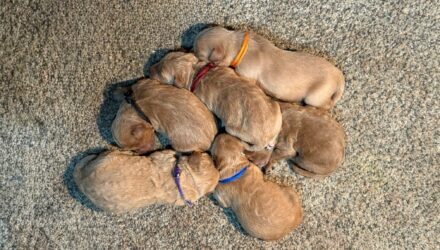
Mouse’s and Marlo’s pups
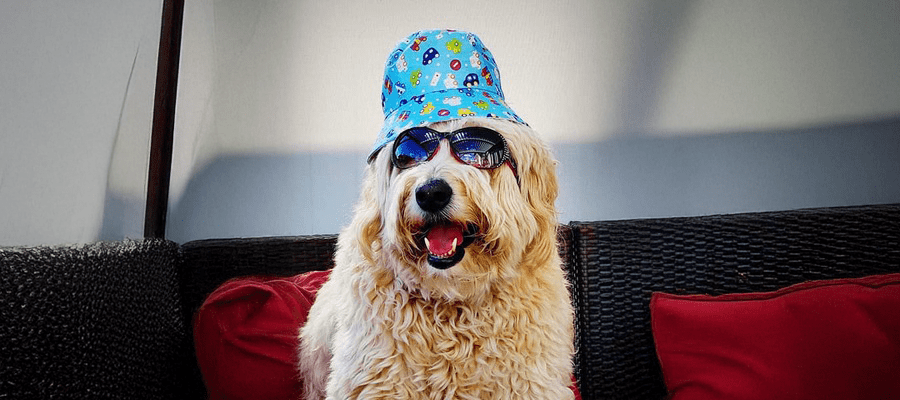
A Tribute to Barkley, Our Best Boy
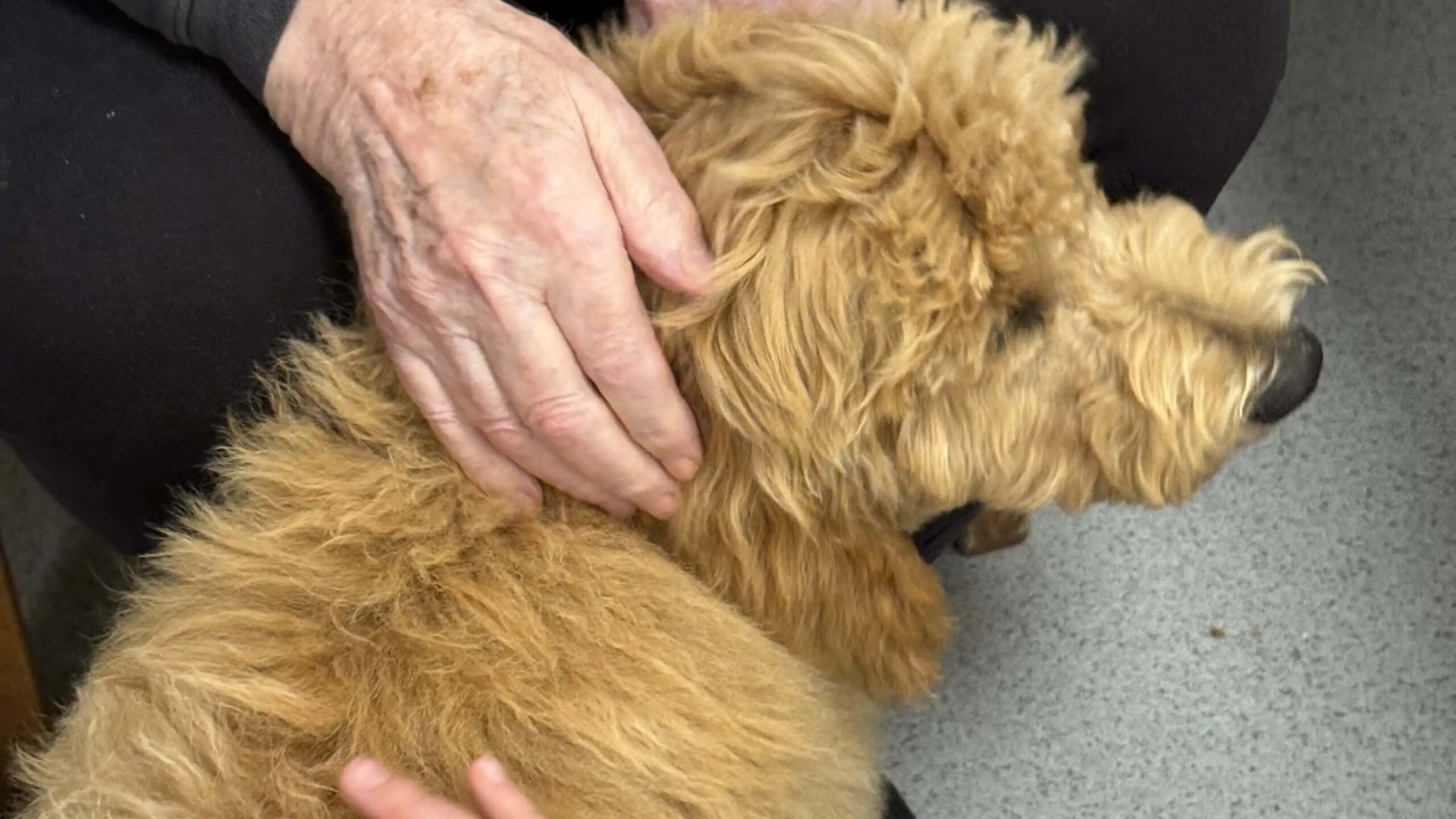
Dog Sharing with Your Goldendoodle
Goldendoodles in Alberta
Our Gallery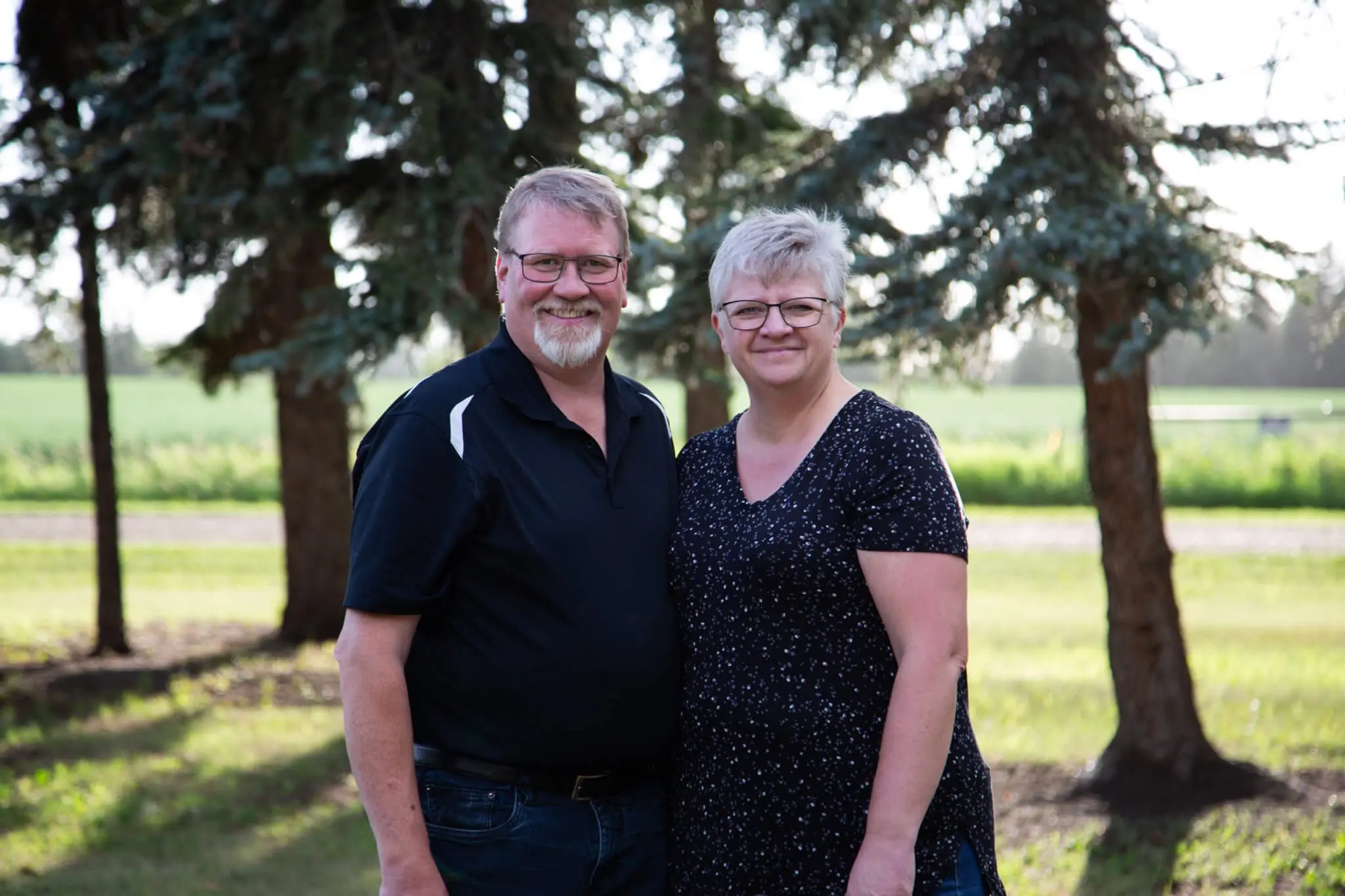
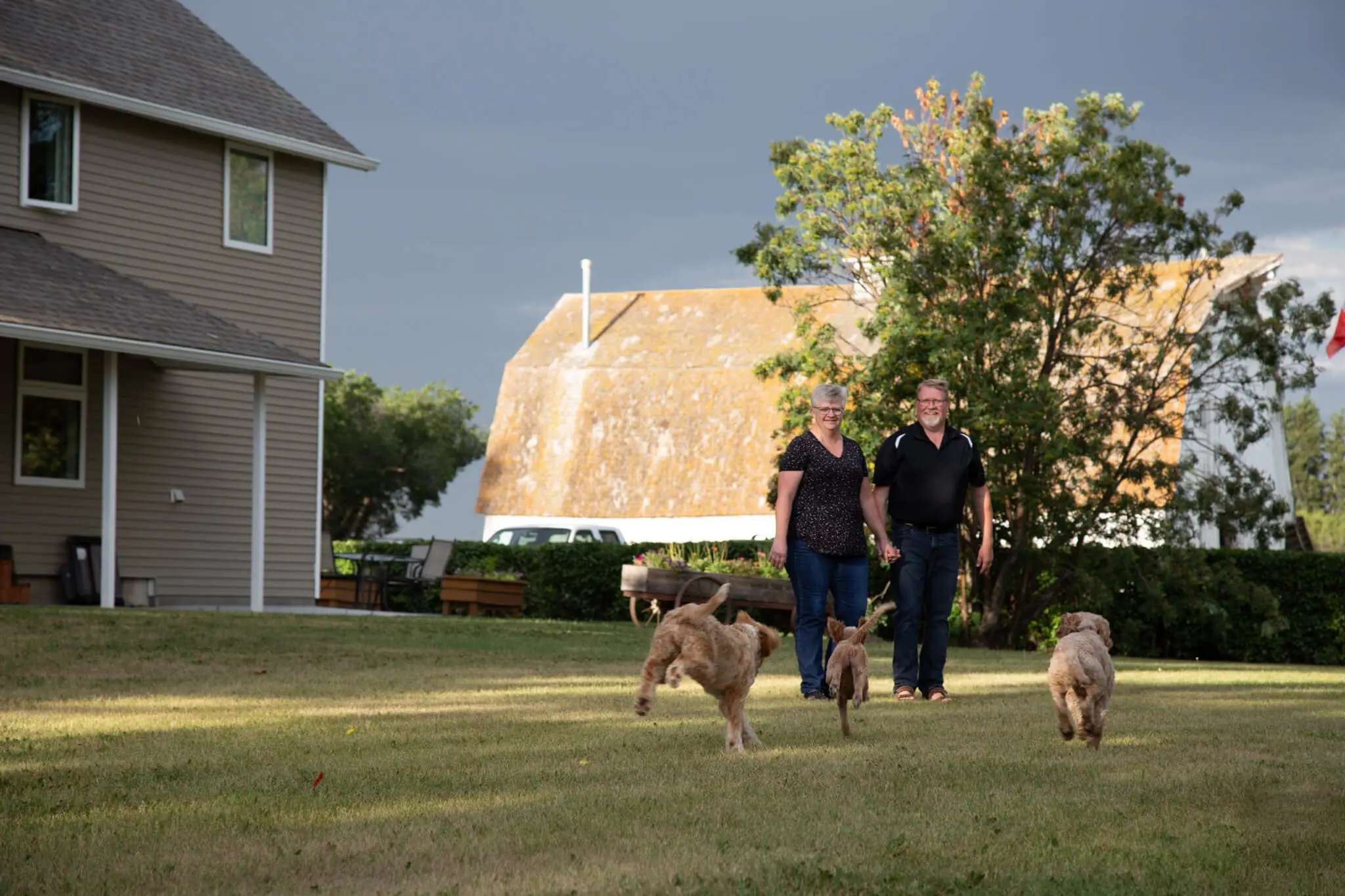
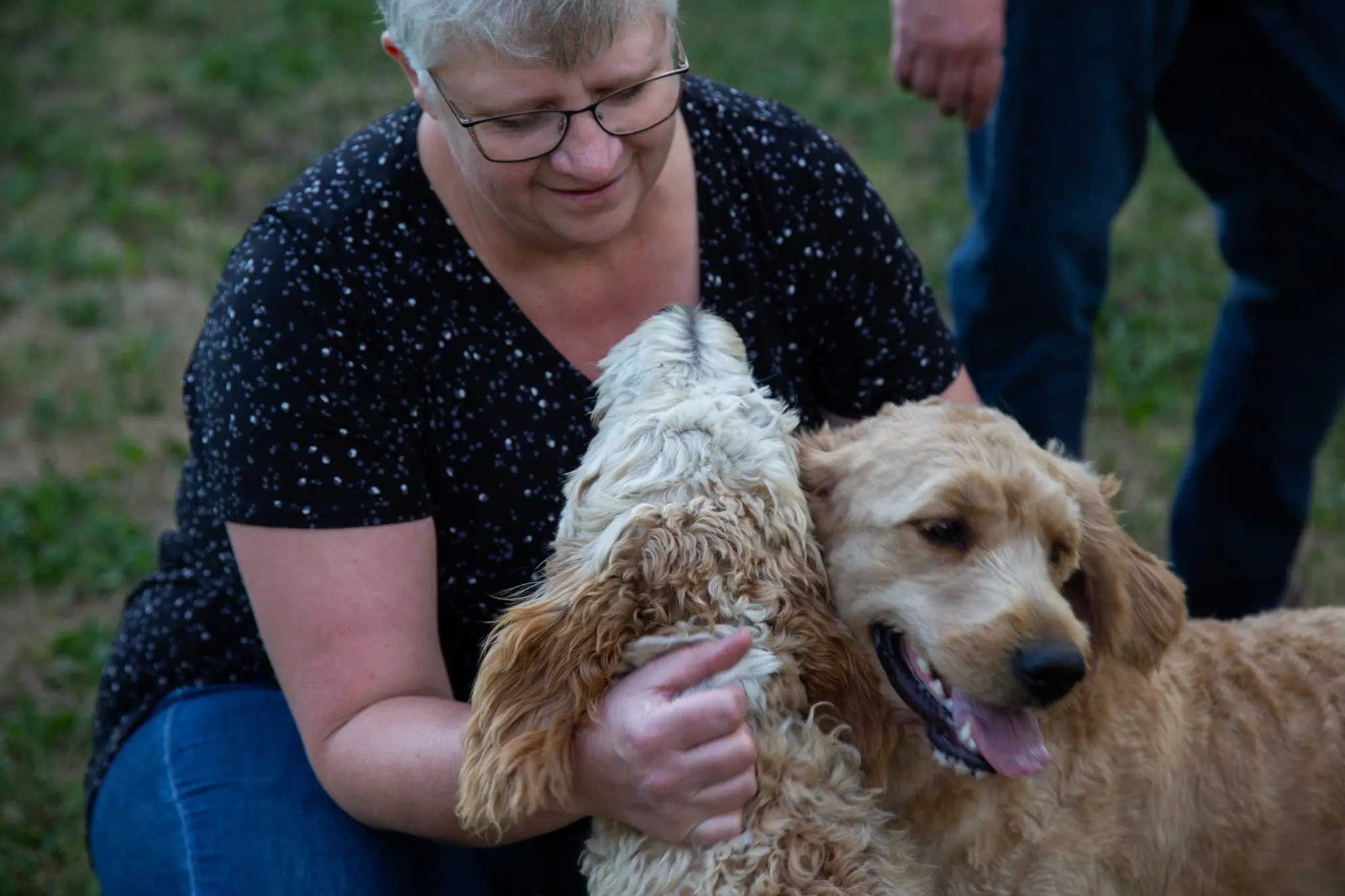
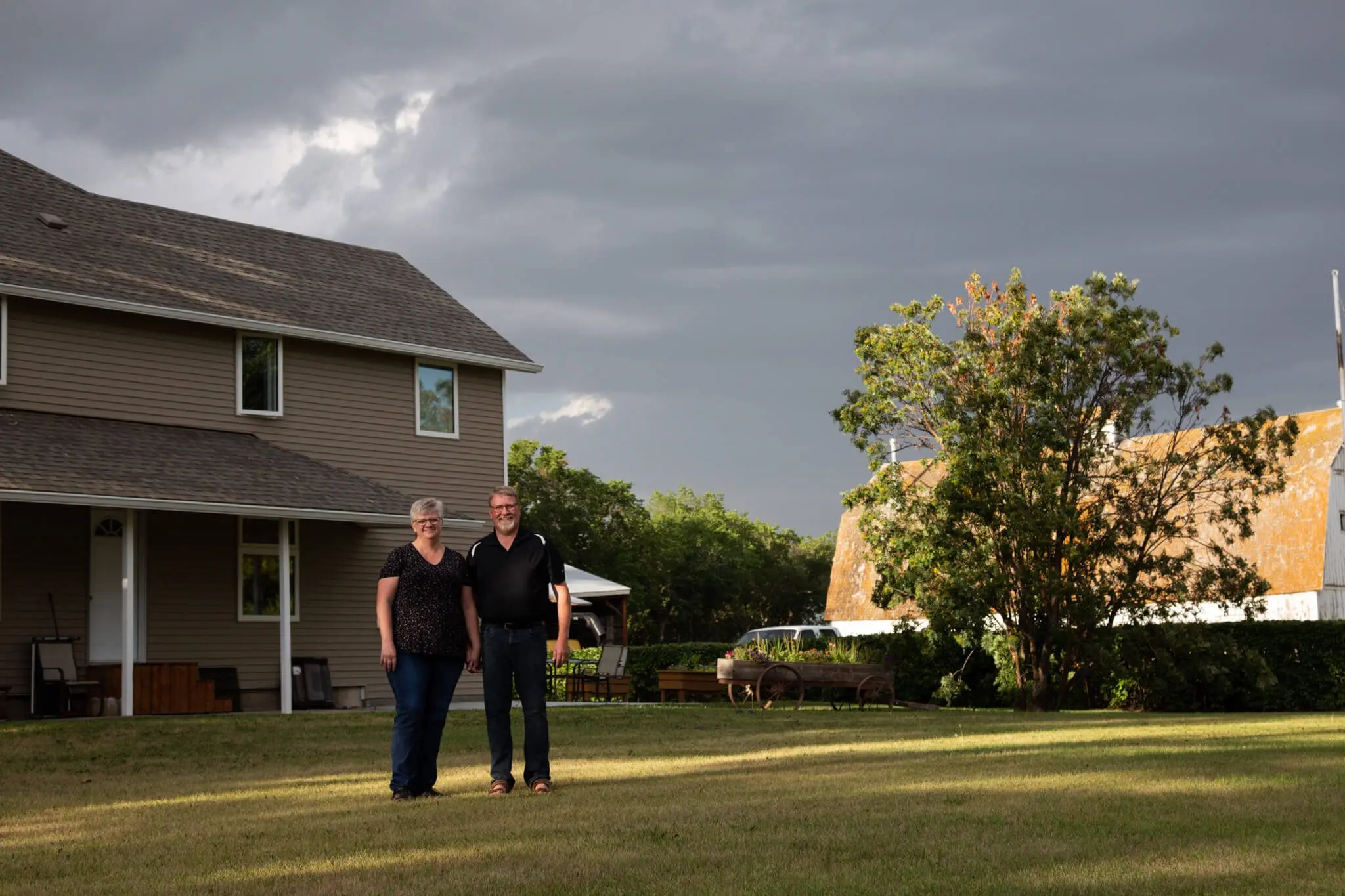
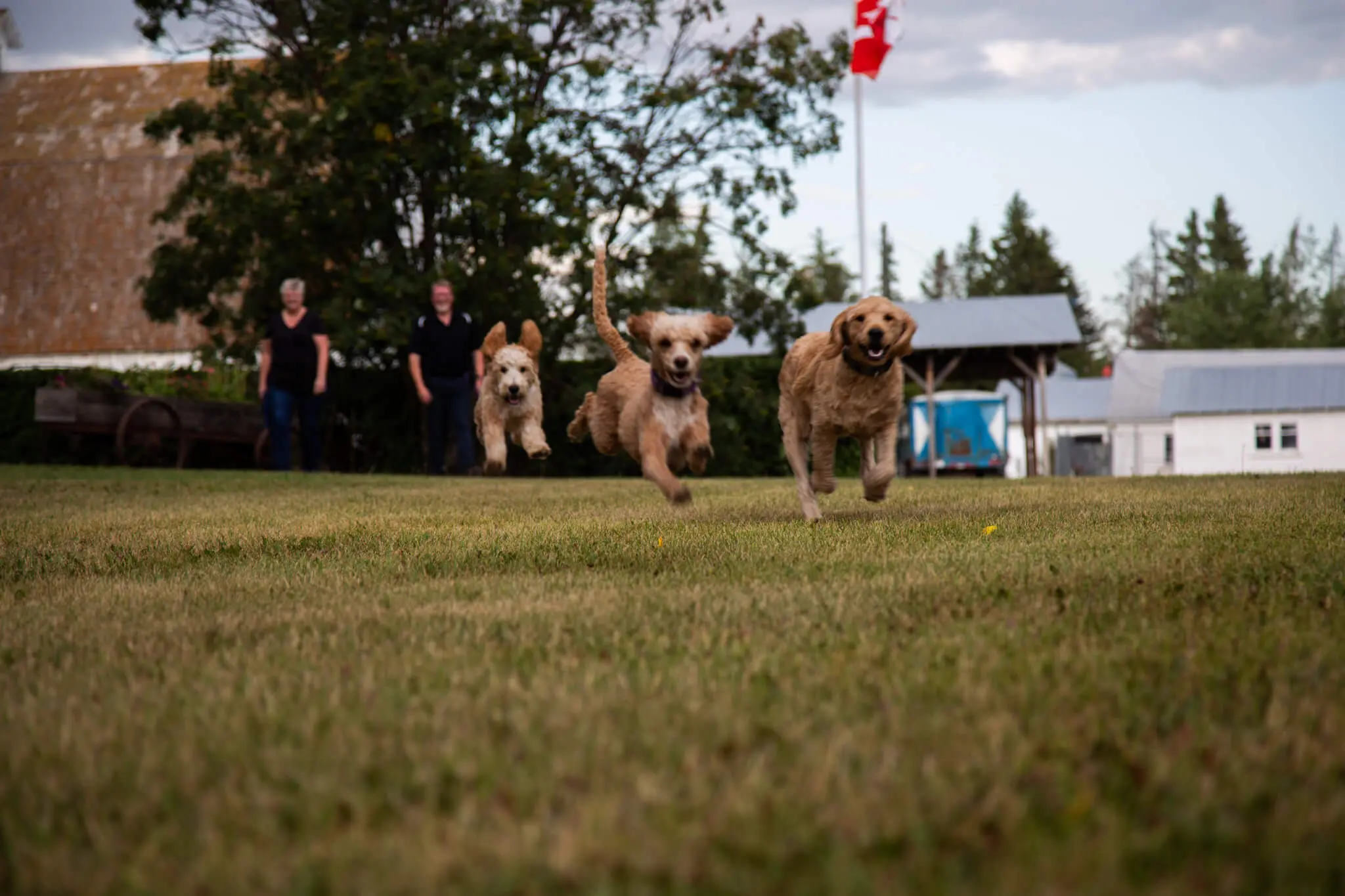





More Photos on Our
Instagram
